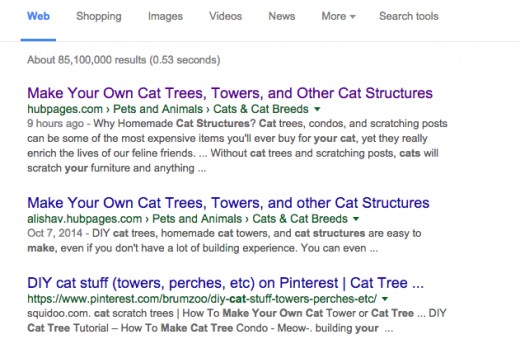What Happens When 301 Redirecting a Large Site
Why Change URLs?
There are a handful of reasons sites want to do large scale 301 redirects.
A few common reasons
- Moving site: A site wants a new domain
- Reorganizing an existing site: A site wants to move content into a logical directory structure for content organization purposes
The observations here are based on reorganizing a site on the same domain to create logical content organization and to improve the presentation of URLs in mobile search results. We also chose to move from subdomains to subdirectories so that we can access all of our data in Google Search Console.
After we are done, we expect URLs to be displayed like this:
Google should display URLs like this on desktop for a Hub with this URL (http://hubpages.com/animals/Bee-Stings-on-the-Eye)
hubpages.com › … › Farm Animals & Livestock › Bees & Beekeeping
and like this on mobile
hubpages.com › animals › Bee-Stings-on-the-Eye
How Long Will It Take For Google To Re-Index a Site after Redirecting
We are moving about 250,000 indexible articles to a new URL structure, plus thousands of QnA and forum pages. The time it takes for Google to fully move a site completely appears to vary by URL to URL and not by site.
Some of our very strongest pages moved within a few days, while other popular pages appear to move in stages. Our assumption is pages with strong backlinks and more robust signals move more quickly.
Stage One: New URLs and Redirects in Place
Stage one is when the site is launched under the new URL structure with 301 redirects in place.
What we see here is that Google is crawling the site and following the 301s. We see an initial surge in traffic because we may end up with two identical pages ranking for the same queries (the old url and the new url). If two pages show up for the same query, it results in incremental traffic. This stage appears to be short lived and lasts for most queries we follow less than one week.
In the screenshot below, notice the same page is ranking twice, but they have different URLs and, the dates are different. One shows Google discovered it 9 hours ago and the other shows it was last updated in 2014. This is a double listing for a query. Eventually, the pages are consolidated into a single listing.

Stage Two: Partial Processing
Stage two: Partial processing. We don't know exactly what's happening in Google, but we have lots of examples of where a page was previously ranking for several queries. For example a page may have been ranking for query1, query2, query3. The page gets partially processed and it resumes ranking for query1, query2, but not query3. This results in a loss of traffic because the page is ranking for less terms. I call this stage partially processed, but like I said, I'm not sure why/how this happens. Now, if you append "hubpages" to query3 so it looks like "query3 hubpages", you'll likely see the old url rank or even a url with a tracking code or a parameter added to the end of the url. If you click through on one of these old URLs, it will go through a single 301 redirect to the proper page url.
The image below illustrates the traffic moving over to the new URL and then the dip that follows.

Stage Three: Full Processing
The amount of time for each URL to get fully processed seems to vary, but from what we can tell, their rankings will eventually return. It can be a bit nerve wracking to watch this, but if you are concerned that it's taking too long, there is something you can do.
If a page hasn't returned to its previous ranking after two weeks, the best thing to do is to update the content on the page. A fresh date and content seems to jumpstart getting the page back to it's previous traffic levels. This can be a good time to fix up a page and make it even better!
In the example above, it took about ten days for the page to go through the full cycle. After 4 days, the page dropped significantly and seems to have bottomed out 7 days after moving. Days 8 and 9 saw a recovery begin. After day 10, the page had settled in to its previous traffic level.









